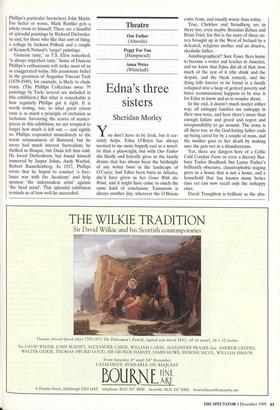Exhibitions 2
Renoir to Rothko: The Eye of Duncan Phillips (The Phillips Collection, Washington, DC, till 23 January)
Emotional release
Roger Kimball
t is worthwhile,' Duncan Phillips wrote in the 1920s, `to reverse the usual process of popularising an art gallery. Instead of the academic grandeur of mar- ble halls ... we plan to try the effect of domestic architecture ... of such an inti- mate, attractive atmosphere as we associ- ate with a beautiful home.'
Anyone who has visited the Phillips Col- lection in the Georgian Revival townhouse at 1600 21st Street in Washington, DC, knows that Duncan Phillips (1886-1966) succeeded spectacularly in his ambition. He created one of the world's great small museums. It has often been said that the Phillips Collection is to French and Ameri- can modern art what the Frick Collection in New York is to the Old Masters.
'Entrance to Public Gardens in Arles-; 1888, by Van Gogh
In many ways this is true. The Frick maintains a more formal, more sombre atmosphere than the genially inviting Phillips Collection. But both museums offer their visitors a carefully thought-out constellation of masterpieces. Like Henry Frick and his advisors, Phillips acquired only those objects he judged to be of superlative aesthetic quality. In 1923, com- menting on his purchase of Renoir's mag- nificent 'Luncheon of the Boating Party' (1880-81), Phillips noted that 'for the American Prado as I am planning, there must be nothing but the best'.
A Yale-educated scion of the Laughlin steel fortune, Duncan Phillips was the kind of large-souled and cultivated man who once upon a time gave culture a good name. Phillips was an evangelist for cul- ture, for the `joy-giving, life-enhancing influence' of art. (Just like the people who run the Tate today, you understand.) While still at Yale, he lobbied for the reintroduc- tion of a course in art history (dropped for lack of interest) and deprecated the whole- sale ignorance of high culture displayed by his peers. One graduate student, Phillips recalled, declared at dinner that 'Botticelli is a wine, a good deal like Chianti only lighter ... He was rudely awakened by a sensitive friend to the fact that Botticelli is not a wine but a cheese.'
Although he studied literature at Yale, Phillips early on cultivated an interest in art. It was not until the devastating deaths in quick succession of his father and older brother when he was in his thirties, howev- er, that he resolved to open a public art gallery and help stand up for the distinc- tion between bottle and Botticelli. The Phillips Memorial Art Gallery, as it was called when it opened in two rooms of Phillips's house in 1920 (eight years before the Museum of Modern Art in New York), was partly an act of homage, partly of catharsis. 'Art offers two great gifts of emotion,' Phillips wrote, 'the emotion of recognition and the emotion of escape. Both emotions take us out of the bound- aries of the self.' Together with his wife Marjorie, herself a painter of modest achievement, Phillips devoted himself to keeping that avenue of transcendence open. He collected art, wrote persuasively about it in numerous books and articles, personally supported several artists, includ- ing Arthur Dove and Stuart Davis, and laboured to make the Phillips Collection an oasis for bruised spirits.
For the current exhibition, the largest in the Phillips' history, the museum's curators Eliza Rathbone and Elizabeth Hutton Turn- er have chosen 350 works from the muse- um's collection of nearly 2,500 objects. The result is both a chronology of Duncan Phillips's evolving taste and stunning array of modem masterpieces. Room after room is filled with extraordinary things: a suite of beguiling paintings by Bonnard, whom Phillips, in 1926, called 'the greatest living painter'; Matisse's 'Quai Saint Michel' (1916); two or three great Vuillards; some brilliant paintings by Ingres, Cezanne, Degas. There are several magnificent paint- ings by Braque, some good Klees, a Picasso or two, a splendid Chardin, some abstrac- tions by Mondrian and Kandinsky.
As the art historian William Agee remarks in his essay for the monumental catalogue that accompanies the exhibition, the Phillips Collection is also 'the best place in the world to see American modernist art'. On view are fabulous pictures by Thomas Eakins, Albert Pinkham Ryder, Charles Demuth (what a watercolourist!); there are excellent things by Stuart Davis, Edward Hopper, Milton Avery, Maurice ,.Prendergast, Arthur Dove and (one of Phillips's particular favourites) John Mann. For better or worse, Mark Rothko gets a whole room to himself. There are a handful of splendid paintings by Richard Diebenko- rn and, for those who like that sort of thing, a collage by Jackson Pollock and a couple of Kenneth Noland's 'target' paintings.
'Genuine taste,' as T.S. Eliot remarked, `is always imperfect taste.' Some of Duncan Phillips's enthusiasms will strike most of us as exaggerated today. His passionate belief in the greatness of Augustus Vincent Tack (1870-1949), for example, is likely to elude many. (The Phillips Collection owns 79 paintings by Tack; several are included in this exhibition.) But what is remarkable is how regularly Phillips got it right. It is worth noting, too, to what great extent taste is as much a principle of exclusion as inclusion. Savouring the scores of master- pieces in this exhibition, we are tempted to forget how much is left out — and rightly so. Phillips responded immediately to the warm sensuousness of Bonnard, but he never had much interest Surrealism; he thrilled to Braque, but Dada left him cold. He loved Diebenkorn, but found himself unmoved by Jasper Johns, Andy Warhol, Robert Rauschenberg. In 1927, Phillips wrote that he hoped to conduct `a free- lance war with the Academy' and help sponsor 'the independent artist' against `the herd mind'. This splendid exhibition reminds us of how well he succeeded.



















































































 Previous page
Previous page